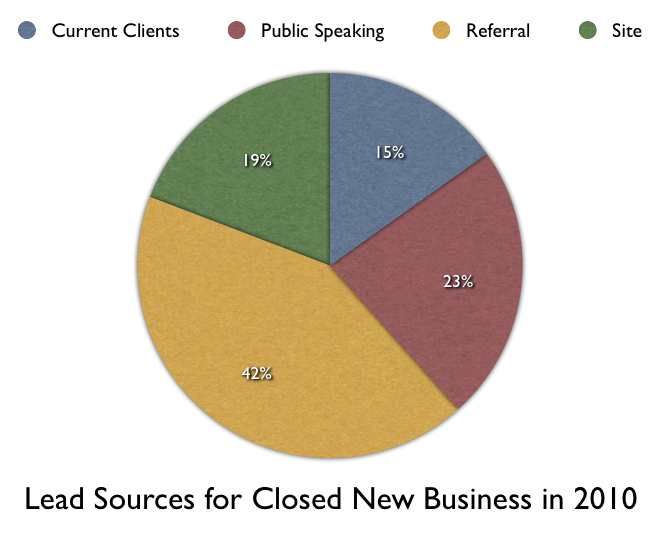At Newfangled, we talk a lot about content. We talk about why it’s important, how to create it, optimize it, distribute it, share it, and generally how to milk it for all it’s worth. What we don’t talk about much is what it actually can get you, in dollars and cents, and I’d like to open up that topic here.
I was meeting with an agency partner in Chicago a few months ago. We were in an all-day planning session for a suite of new sites we’re building with them and the topic of website leads came up. I had mentioned something about the role of content creation in a lead-generation marketing plan, and the principal, in a kind but slightly challenging way, said something along the lines of “easy for you to say, Newfangled probably gets all its leads from referrals.”
I knew his assumption wasn’t correct, but I realized at the same time that I didn’t have the data to prove it. I actually wasn’t sure what the lead origination sources of our closed new business were, exactly. Not having this data at my fingertips was a problem for a number of reasons, so I decided to trace all of the projects we closed in 2010 back to their lead source.

As you can see in the chart above, referrals, at forty-two percent, actually account for quite a large percentage of our closed new business. Our content, however, which is the foundation of both our site and public speaking, also accounts for a total of forty-two percent of our business in 2010. What this literally means is that if we did not have a content strategy, we would have sold forty-two percent less work in 2010. So, in our case, content is worth forty-two percent of our business.
This might sound controversial, overstated, or conflated, but it’s not. It’s absolutely true, and it touches on something I’ve been thinking about quite a bit lately.
What Is the Cost of Not Implementing a Content Strategy?
We’ve managed to significantly improve across the board as a business through the recession. Don’t get me wrong, we haven’t made it through the past three years unscathed, but we’re in a much better spot today than we’ve ever been as a business and this hasn’t been the easiest climate in which to improve. I think there are a number of reasons we’ve been able to be so fortunate, but I see our marketing as a key factor, and our marketing is based on our content. I can look at the relationship between our content and our health as a business in two ways. I could say, wow, this is great, we invest heavily in our content and we’ve been doing well. The other way of looking at this is to consider what our business would look like without our content, and I can’t do that for too long or else I’ll start to panic. A vision of Newfangled without the benefits and opportunities we’ve received from implementing our content strategy is not a pretty sight.
I decided to write this series of posts because I know that many agency principals are currently trying to assess the benefits of a content strategy, and I wanted to offer an open perspective on what our experience has been.
How Content Generates Leads
So I’ve now gone on record saying that I know, for certain, that forty-two percent of the business we closed in 2010 was from leads that originated via our content. I know this because I listed every job out, and looked back to see how those people made their initial contact with us. This data set is only as good as the honesty of the people who tell us how they found us, but if we can’t trust that then the whole practice of measuring lead origination would be meaningless, and I think measuring lead origination is not only meaningful, but crucial. We’re a small business, and the time and money we devote to marketing is precious. I need to know what activities are giving us the right exposure that leads to business so that I can focus the few marketing resources we do have on those activities.
Initially, our content exposes us to our audience. After they discover us, they usually end up on our site, which is entirely designed to bring our core audience (marketing firms) into some level of engagement with us so that we will be top of mind when they need to hire a developer to help them on a website project. The element of our site that guides our visitors from the first page they land on to a web form they will use to convert (newsletter, blog, webinar signup, contact us, etc.) is, again, our content. What’s more, the tool that allows us to keep Newfangled at the top of our prospects’ minds through the newsletters, webinars, and blogs they sign up for is, again, our content. Our content is one of the primary ways our prospects initially discover us, it is the primary way we convince them of our expertise and encourage them to give us their info in exchange for the convenience of having our content automatically delivered to them, and it is the primary way we nurture our leads.
It’s Not Just About the Content on Your Site
We also are involved in quite a few off-site activities that are very much part of our overall content plan. These marketing activities include book publishing (Chris Butler and I are each putting out a book this year), public speaking, and writing for industry blogs and magazines. When you view our content strategy as not just being comprised of what’s on our site, but rather comprised of everything I just mentioned, it becomes clear that our content strategy isn’t part of our marketing plan, it is our marketing plan.
How Much Does Content Creation Cost?
I mentioned that forty-two percent of the jobs we closed in 2010 initially found us through our content, so that’s the return on investment—but what’s the investment? Since we are time-keeping sticklers we’ve got the data for this, too. Last year we invested approximately 1,000 hours in our content strategy, or, about twenty hours a week across the firm.
There are two ways we could measure these twenty hours per week; we could measure based on the actual hourly cost (to us) of the person creating the content, or we could measure based on our hourly billable rate. It’s not practical to base this marketing investment on a billable rate. If the investment were measured this way, no one would implement a content strategy.
If we are measuring the cost based on the employees cost to us, then twenty hours a week is a convenient number because that’s roughly equal to a half-time employee. According to Salary.com, the average “designer” makes about $50k per year. If we use this as a benchmark, we could say that we invested $25k of our own time into our content. Investing $25k of time to expose Newfangled to people who ended up comprising forty-two percent of our business sounds pretty good to me.
The Peripheral Benefits of Content-based Marketing
That investment is very different than a typical marketing investment. There are two aspects of a content strategy investment that should be understood and considered when comparing it to other sorts of marketing investments.
Benefit 1: Longevity
We didn’t spend $25k to buy an ad in a magazine that will be tossed aside in a few months. We know that the investment in our content, particularly our on-site content, will work for us every hour of every day for years to come.
Just today we received a lead through the site that is a perfect example of this. The prospect searched for “create technical website specifications.” That is a perfect search phrase in my eyes. It is not branded (no mention of Newfangled, its properties, or its employees), and it is entirely related to our expertise. The searcher is in the U.K. and has a need for a web expert to work with the design firm they hired to help with the information design of the new site. In many ways, they appear to be an ideal prospect for us. The article they landed on after performing that search happens to be from a newsletter we wrote ten years ago. That’s right, ten. So, while I was having breakfast with my family in North Carolina, a prospect from the U.K. asked Google to refer them to someone with very specific web expertise, found us through a decade-old article, and asked us to call them about a job. The content investment we made ten years ago is performing as well today as it ever has.
Benefit 2: Intelligence
Almost everyone inside of Newfangled contributes to our content. In the past month, Lindsey, Lauren, Chris Creech, Chris Butler, Steve Grothmann, Justin, Katie, and I have all contributed content to the site. The time our employees invest in our content is not just an expense we can assign to marketing, it is one we can also assign to education. No matter who is creating the content, I know we all learn a great deal from the content we create—be it when we’re researching and writing the piece ourselves or when we’re reading what one of our peers wrote. We’re investing in our expertise each time someone writes a blog post.
What’s Next: Examples
This topic is a pretty significant one, so I will be following up this lengthy post with three shorter posts that point to concrete examples of how our content strategy has worked for us. In the next three posts, we will look at the past, present, and future benefis of our content strategy.

